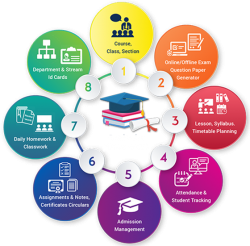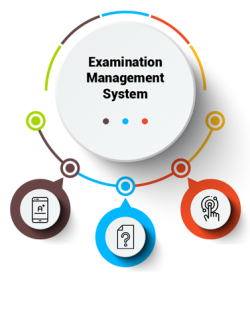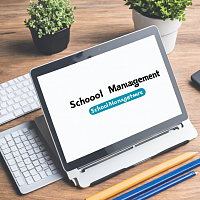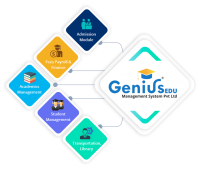Increasing School Effectiveness by a School Management System
Introduction
Hey there, folks! Let's talk about something that's been making waves in the education sector lately - School Management System (SMS). These digital platforms are transforming schools' operations, making them more efficient, effective, and engaging.
According to a report by Grand View Research, the global market for school management systems is expected to reach a whopping $25.7 billion by 2027, growing at a compound annual growth rate (CAGR) of 17.7% from 202 to 2027 (1). That's a lot of schools jumping on the SMS bandwagon, and for good reason!
So, what's all the fuss about? A school management system is a software application that automates and streamlines a school's administrative tasks. It's like having a super-efficient virtual assistant that never sleeps. An SMS does everything from managing student data, staff records, and academic progress to handling admissions, fees, and communication.
But how does this translate into increased school effectiveness? Let's break it down.
Firstly, an SMS significantly reduces administrative workload. A study by the National Center for Education Statistics in the US found that principals spend about 30% of their time on administrative tasks (2). By automating these tasks, an SMS frees up time for school leaders to focus on what matters - improving teaching and learning.
Secondly, an SMS enhances communication and collaboration. It provides a centralized platform where teachers, students, parents, and administrators can share information, discuss issues, and work together. This fosters a sense of community and improves student engagement and achievement. A study by the American Psychological Association found that students who feel a sense of belonging at school are more academically motivated and have higher GPAs (3).
Thirdly, an SMS improves data management and decision-making. It provides real-time access to a wealth of data, from student attendance and grades to budget reports and staff performance. This allows school leaders to make informed decisions, track progress, and identify areas for improvement. According to a report by McKinsey, schools that use data-driven decision-making have seen significant improvements in student performance (4).
However, it's important to consider diverse perspectives. While many educators and administrators are excited about SMS's potential, others are concerned about data privacy, cost, and the digital divide. Schools must choose a secure, affordable SMS and provide training and support to ensure all staff and students can benefit.
Increasing School Effectiveness by a School Management System
A school management software can be a game-changer for educational institutions aiming to boost their effectiveness. Centralizing various administrative tasks offers a streamlined approach that saves time and resources. This efficiency allows educators to focus more on teaching rather than juggling paperwork.
With comprehensive features like attendance tracking, grade management, and report generation, these systems help schools effortlessly maintain accurate records. Real-time access to data enables teachers and administrators to make informed decisions quickly, and student engagement often increases when teachers have the tools they need.
Communication plays a crucial role in any learning environment. A robust school management system enhances communication channels among students, parents, and staff members. Announcements can be instantly shared via notifications or email, informing everyone about important events or changes.
Moreover, such systems promote collaboration between departments within the institution. Whether sharing resources or coordinating class and meeting schedules, seamless interaction fosters a supportive community focused on student success.
In an era when technology is integral to education's evolution, adopting a school management system signifies moving toward modernity while enhancing overall effectiveness in schools worldwide.
Overview of School Management Systems
A School Management System (SMS) is a comprehensive software solution to streamline educational institutions' administrative functions. It is a centralized platform that integrates various aspects of school management, including student enrollment, attendance tracking, grading systems, and communication between educators and parents.
These systems are tailored for different educational environments, from primary schools to universities. They help automate day-to-day operations while enhancing overall efficiency. By minimizing paperwork and simplifying processes, SMS allows staff to focus more on teaching than administrative tasks.
These platforms have user-friendly interfaces that cater to teachers, students, and administrators alike. Educators can easily access attendance records or generate reports with just a few clicks, which fosters better collaboration among all stakeholders in the education system.
Additionally, many school management systems offer features like online portals for students and parents. These portals provide real-time updates on academic performance and essential announcements—keeping everyone informed in one place.
The increasing reliance on technology in education has made SMS an essential tool for modern schools aiming for effectiveness and improved outcomes.
Benefits and Features of School Management Systems
A school management system offers various benefits that streamline administrative tasks. One of the primary features is centralized data management. This allows schools to store student records, attendance, and grades in one secure location, making information retrieval quick and efficient.
Communication tools are another key benefit. Many systems include integrated messaging platforms for teachers, students, and parents. This ensures everyone stays informed about critical updates or changes within the school community.
Automation significantly reduces manual workloads. Tasks such as report generation, scheduling classes, and managing admissions can be automated to save time and minimize errors. Educators spend less time on paperwork and more on teaching.
Analytics capabilities provide valuable insights into student performance trends over time. Comprehensive reporting features help schools quickly identify areas needing improvement or recognize high-achieving students.
User-friendly interfaces enhance accessibility for all users—teachers, administrators, students, and parents. A well-designed system invites engagement from its users while ensuring ease of navigation across various functions.
Case Studies: Success Stories with School Management Systems
Many schools have embraced school management systems, transforming operations and enhancing student outcomes. For instance, a mid-sized high school in Texas adopted a comprehensive school management system that streamlined attendance tracking. Teachers could easily mark absences online, reducing administrative workload and improving accuracy.
Another success story comes from an international school in London. They integrated a cloud-based platform to manage grades and parent communication. This allowed parents to access real-time updates about their children's performance, fostering stronger relationships between families and teachers. The result? Increased parental engagement led to improved student motivation.
In India, a rural primary school implemented a mobile-friendly management system tailored for limited internet connectivity. Despite the challenges of its environment, the software helped teachers plan lessons more effectively and monitor student progress efficiently—an incredible leap forward for education access.
A private institution in Canada focused on data analysis through its newly adopted school management system. By leveraging analytics tools within the software, it identified areas needing improvement in curriculum delivery, which ultimately enhanced students' overall learning experiences.
These examples illustrate how impactful adopting an effective school management system can be across diverse educational contexts.
Choosing the Right School Management System for Your Institution
Choosing the right school management system is crucial for any educational institution. Start by assessing your specific needs. Consider factors like student enrollment, attendance tracking, and academic performance monitoring. Each school has unique requirements that must be addressed.
Evaluate user-friendliness as well. A complex system might deter staff from fully utilizing its features. Opt for a platform that offers intuitive navigation to ensure quick adoption among teachers and administrators alike.
Next, look at scalability. As your institution grows or changes, so should your chosen system. Ensure it can adapt to evolving needs without requiring a complete overhaul.
Integration capabilities are also vital. Your school may already use other software solutions—to ensure the management system can seamlessly integrate. This will save time and enhance data accuracy across platforms.
Consider the vendor's customer support options. Reliable technical assistance is essential during implementation and beyond so any issues can be quickly resolved without disrupting daily operations.
Best Practices for Implementing a School Management System
Implementing a School Management System can transform an institution's operations. The first step is to assess your school's specific needs. Involve teachers, administrative staff, and students in discussions about the features that would benefit them most.
Next, choose a user-friendly platform. A complex system may lead to frustration among users. Training sessions are essential for staff and students to ensure everyone feels comfortable using the new tools.
Data migration is another critical aspect. Carefully plan how existing data will be transferred into the new system without loss or corruption. Creating backups before migrating data can save a lot of headaches later on.
Open lines of communication during implementation are vital, too. Regular updates regarding progress help keep everyone informed and engaged with the transition process.
Monitor usage closely after implementation. Gather feedback from all stakeholders regularly to identify any issues or areas for improvement within the School Management System as it evolves.
Security and Data Protection in School Management Systems
Security and data protection are critical aspects of any school management system. Schools handle sensitive information, including student records, financial details, and staff data, and protecting this information from unauthorized access is paramount.
Most school management systems incorporate various security measures to safeguard data. These may include encryption protocols that protect data in transit and storage. Multi-factor authentication adds an extra layer by ensuring that only authorized users can access the system.
Regular updates and patches are essential for maintaining security standards. Developers often release updates to address vulnerabilities as they arise. Implementing these updates promptly helps keep the system secure against potential threats.
Data backups also play a vital role in protecting school information. Regularly scheduled backups ensure schools can recover their data quickly in case of accidental loss or cyberattacks. This proactive approach minimizes disruptions to daily operations.
Training staff on best practices for using the school management system significantly enhances security efforts. Educated users are less likely to fall victim to phishing scams or other malicious activities that could compromise sensitive data.
The Future of School Management Systems
The future of School Management Systems is bright and full of potential. With rapid technological advancements, these systems are evolving to meet the needs of modern educational environments. Schools are increasingly adopting cloud-based solutions that provide flexibility and scalability.
Artificial intelligence is set to play a significant role in enhancing school management systems. AI can automate administrative tasks, allowing educators more time for personalized instruction. Predictive analytics will enable schools to anticipate student needs and improve outcomes effectively.
Mobile access will also shape the future landscape of school management systems. As smartphones become ubiquitous, parents, students, and teachers expect seamless connectivity. This shift encourages greater engagement among all stakeholders involved in education.
Integration with other technologies like learning management systems (LMS) will enhance functionality further. This interconnectivity promises a holistic approach to managing educational processes while streamlining communication between staff members and families.
Data privacy remains paramount as these systems advance. Schools must prioritize security measures to protect sensitive information while maintaining compliance with regulations like GDPR or FERPA. Striking this balance ensures trust within the community as they embrace innovations in school management.
Conclusion
The adoption of a school management system is transforming how educational institutions operate. By streamlining administrative tasks, enhancing communication, and improving data accessibility, these systems are paving the way for increased effectiveness in schools.
Schools that embrace technology can better focus on their core mission—educating students. A well-chosen school management system addresses current challenges and anticipates future needs within the education landscape.
As we look ahead, it's clear that technology's role will continue to expand in education. Schools investing in comprehensive systems today set themselves up for success tomorrow. With careful planning and execution, leveraging a school management system can lead to significant improvements across all areas of an institution's operation.
Every educational leader must consider how such tools can enhance their school's performance while ensuring security and compliance with data protection regulations. The journey toward greater efficiency begins with informed choices and strategic implementation of innovative solutions tailored to each institution's unique requirements.










